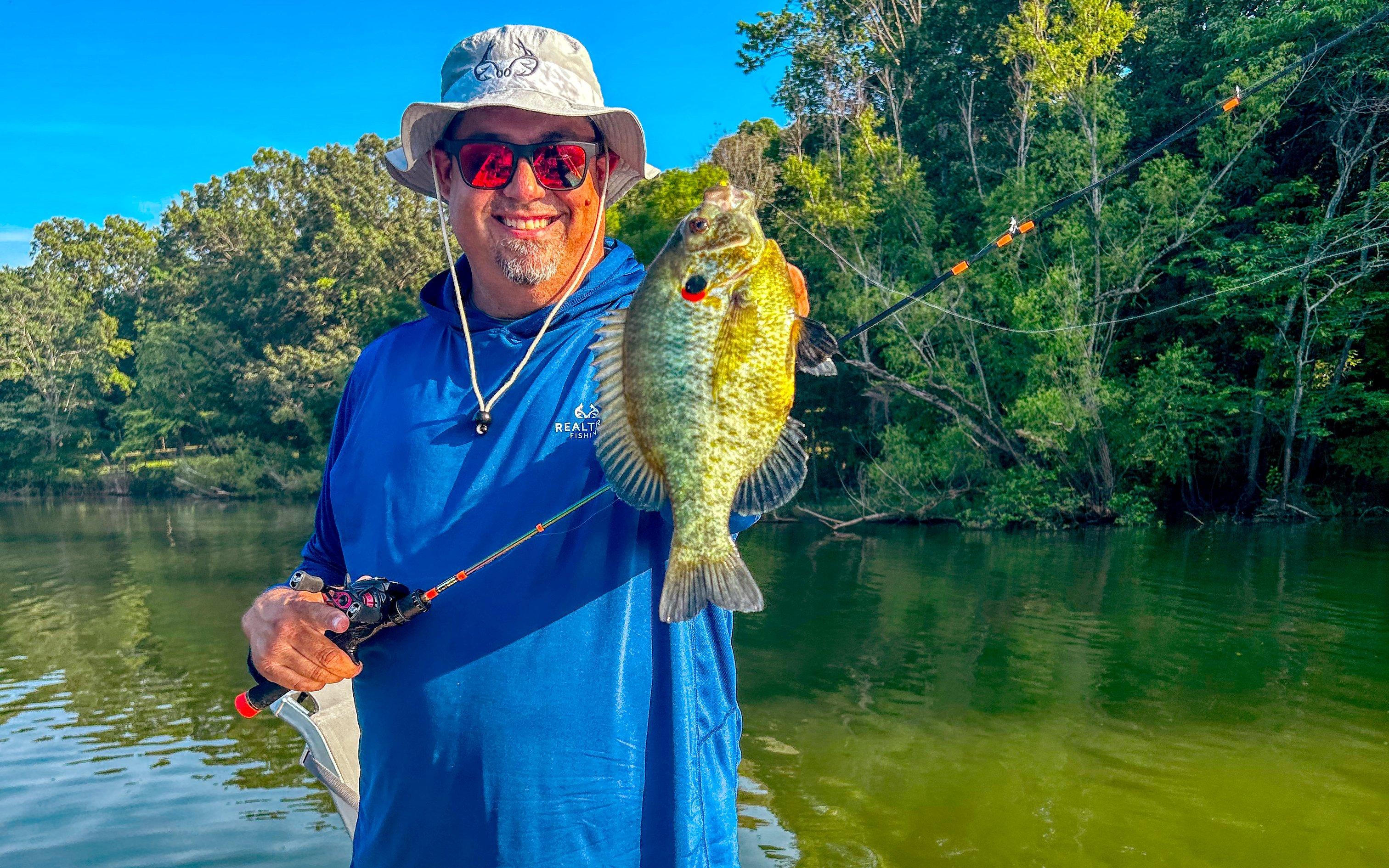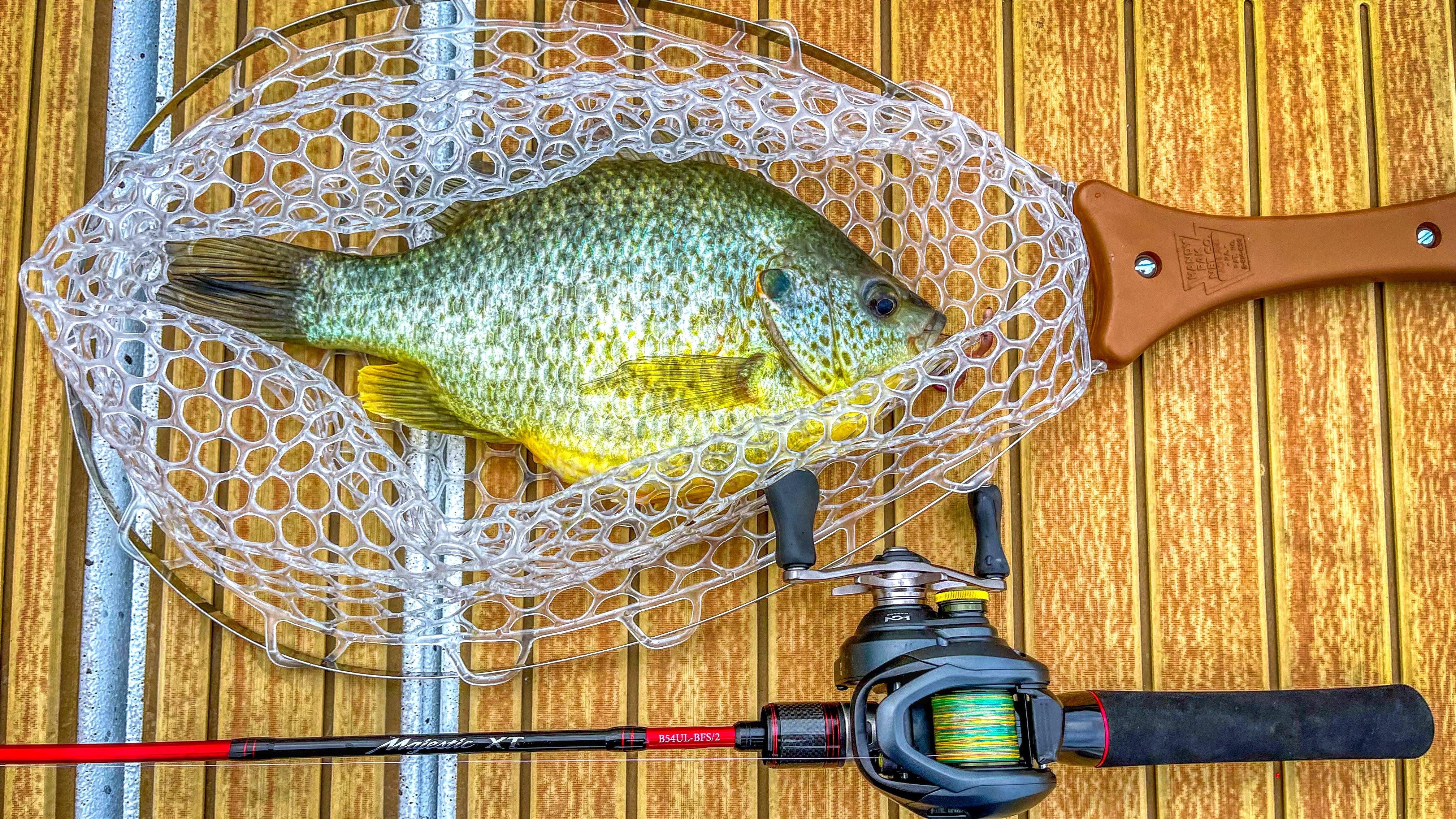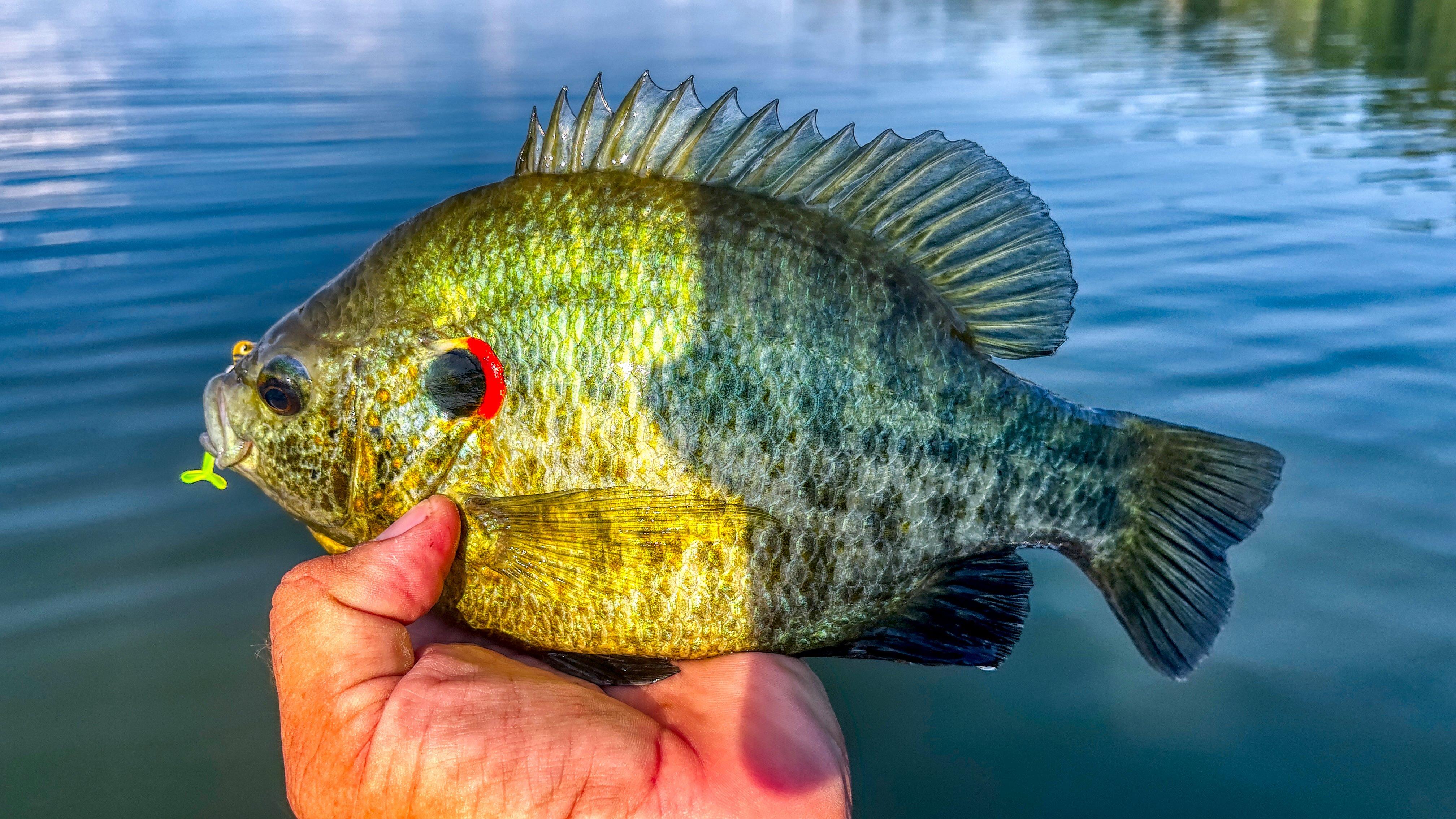These magnum panfish, sometimes called shellcrackers, are hard fighters and prized on the table

The author, Jason Sealock, shows off a nice redear sunfish. (Image provided by Jason Sealock)
Redear sunfish go by many names including shellcrackers, chinquapin, cherry gills, and sun perch. Regardless of what you call them, they’re pound-for-pound some of the hardest fighting fish in the lake and, because they get much larger than bluegills, they’re highly sought after by anglers. But the fish are also notoriously mysterious. Little is known about where redears go at various times of the year, how to find them, and the best lures for tempting them into biting. Redears are uniquely evasive when it comes to finding them on a consistent basis, but spring is the one time of year when the angler’s odds go way up.
I’ve spent the better part of two years learning all I can about redear behavior and can definitely say spring is the most consistent time to catch them, though I’ve caught them 12 months of the year. When redears move shallow to feed in the prespawn, make nests during the spawn, and feed back up in the post spawn, they get a lot easier to pattern and catch if you know some simple behaviors.
SPRING REDEAR MIGRATIONS
Redears are said to be bottom feeders because, as their nickname suggests, the do eat a lot of freshwater snails and mussels. But snails are not all they eat. And they also don't only feed on the bottom. Redears will feed on crustaceans, invertebrates, bugs, worms, and even small baitfish.
Redears will spend the winter hunkered on bottom in cold water, usually mixed in with big schools of bluegills on large reservoirs. Then as the waters warm in the spring, they make their way to the points and lead-in banks searching for their favorite food source, which is freshwater shellfish. Banks with tiny visible shells are always worth checking. If you find banks like that with some deep water close by, you're going to probably find a few redear scattered throughout during the prespawn migration from deep water.
I often start looking for them on points, steeper banks leading to historical spawning areas, and ditches leading to flats. As the water continues to warm, redears will start moving shallower and staging in some very obvious places like laydown trees and ditches prior to the spawn. Some of the best redear fishing I've ever seen was on the last ditch going into a flat pocket in the back of a bay. We caught 29 big ones that day from one ditch. Likewise, I've caught a lot of nice redears corking jigs and red worms around laydown trees during the last little window before the spawn.
Don’t Miss: How to Fish for Shellcrackers
Usually in the spring, crappie will spawn first, then the smallmouth spawn, then the largemouth spawn and at the tail end of the largemouth spawn, the bluegills and redears will come in to spawn. On my home lake, Memorial Day weekend is generally primetime spawning season for redears. Though I’ve found them spawning in April, most of the spawn will happen in May when the water temps are going into the 70s.
After the spawn, redears will move out again. High spots with stumps are great places to find them leading out to deep water where they will move to in the summer. I have had some dynamite days chasing redears on humps with stumps after the spawn, and I’ve often found them grouped up again feeding with bluegill in these areas before going out and suspending in the summer.

An angler’s odds for catching redear go way up in the spring. (Image by Jason Sealock)
SPRING HOT SPOTS FOR SHELLCRACKERS
As mentioned, laydowns are dynamite redear holding places. Some of the best redear nests I've found have been down one side of a laydown and up the other. I could pitch or lower jigs with bobbers into holes in the limbs and snatch fish out one by one. It's obviously a little trickier around all those limbs. I like a jig on a long rod for this with a small float. If it's a really calm day, I will ease around with my trolling motor on 1 or 2 and make very short pitches into openings. I like a bobber for this as it keeps my jig sitting in one place easily without getting tangled before a bite.
When redears are on beds, don't be afraid to get really shallow and look under trees, next to dock posts, or at the base of standing cypress trees. These are all places I find sneaky, big redears in the spring. You will be surprised how shallow they make their beds. They will also relate to stumps, stake beds, and other woody things that most anglers consider crappie cover. I've caught some giant redears out of crappie mats after the crappie moved to deeper water. So always pitch around them in the spring. Shellcrackers actually like wood cover a lot, since it attracts snails.
If you are good at finding big bluegill beds in the spring, most will have a few big redear beds with them. They will typically be on the fringe or edge of the bigger bed or against cover, like a log or laydown. You will be looking for slightly larger or deeper beds (identified by bigger or more pronounced rings if you are sight fishing). If you find a good bluegill bed, be sure to expand your area of fishing because there are likely some redears around the fringe.
I've caught a bunch of big redears around cypress trees as well. This can be a dynamite pattern in and of itself. You can run a lot of trees with a simple cork and jig or cork and worm or cricket if you prefer live bait. I've actually spent the last two years only fishing for redears with jigs and have found I don't really need live bait anymore.

Ultralight and bait finesse tackle is ideal for catching redear in the spring. (Image by Jason Sealock)
SPRING REDEAR GEAR
When it comes to panfishing, I love ultralight and bait finesse tackle. I often use 2-pound line on short, ultralight spinning rods made for trout and other gear to coax wary redears into biting. But your gear can be as simple or sophisticated as you want. That's what I love about panfishing. You can fish how you like to fish with just about any kind of gear and have a ball fishing for them.
I think 4-pound line is a great starting place. Mono works great and fluorocarbon probably helps a little more if you can handle it on spinning gear. I catch a lot of fish on braid with a fluoro leader on my BFS setups. But I've caught just as many fish on 4-pound mono. So, again, you don't have to use expensive gear to be successful.
A bobber and a small jig work very well on redears. I like hand-tied bugs like the ones from Starky Flies on Etsy for example when bobber fishing. I personally prefer a pinch-on bobber. The Trout Magnet floats with the slit on them are cheap, fast, and work great. And when using 2-pound line, you can worry less about the bobber compromising your line integrity. Most of the time, I'm fishing shallow, so I only set the bobber 1 to 3 feet above the jig.
Don’t Miss: Fishing Secrets for Bedding Bream
Usually, I will pull the bobber about 6 inches, let it settle, and repeat. I also will cast small 1/32- or 1/16-ounce jigs and slowly reel them through flats around cover looking for the more aggressive redears. Usually either the bottom bouncing or floating options will coax most of the redears into biting. You can add a PowerBait nibble or some other scent to increase your odds.
Day in and day out, though, a red worm on a small drop shot rig is hard to beat. Tie on a No. 6 Aberdeen hook with about a 6-inch tag end and then attach that to a 1/8-ounce bell sinker. Then just slowly pull the sinker about a foot and let it sit. Then pull it and let it sit. Most of the time, a shellcracker bite will feel like a bunch of little pecks in a row, and then, it will just ease off with your worm. You can lean into them and enjoy the fight.

As long as there is cover and shade, redears can hold in inches of water. (Image by Jason Sealock)
OTHER REDEAR CONSIDERATIONS
I’ll reemphasize that redears will get shallower than you think. If there is cover and shade, they could be in inches of water. If you catch a few redears from one location, leave it and come back again later. Catching a few fish often stirs up the area and spooks other ones. If you give it time to rest, you can usually slide back in later and get a few more. So, if you find five or 10 areas that have more than one redear, you can usually rotate around and get a nice mess in the spring.
I won a redear tournament years ago with a good friend and to this day, it was one of the most enjoyable fishing days I've ever head. We caught 29 redears, including several over 2 pounds and nearly two-dozen over 1 pound. About half of those bites felt like little minnows pecking our worms. If I had missed the fish on the hookset, I would have told you it was a little fish messing with my bait. But setting the hook on those nibbles almost always produced a big redear.
Follow ditches in from deep water toward cover and shallow areas. Look in sneaky hiding places. Use as light a line as you can, because these fish are finicky. Follow those steps, and you’ll catch the most evasive panfish in the lake with a little more consistency.












